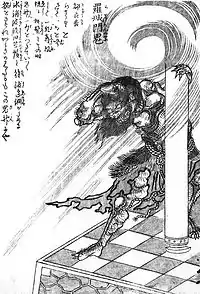Rashōmon (Noh play)
Rashōmon (羅生門) is a Noh play by Kanze Nobumitsu (c.1420).[1][2] Like other celebrated dramas such as the Maodori-hasi and Ibaraki, it is based on the legend of Watanabe no Tsuna and the demon of Rashōmon.[3]

The title is a pun,[4] which involves the Rajōmon outer castle gate but Kanze changed it by using the kanji shō for "life" rather than the original jō for "castle."[5][6] It is one of the few Noh plays where the supporting waki (脇) rather than the normally leading shite (仕手) dominates the action.[7] It is suggested that this can be attributed to the fact that Nobumitsu used to play waki roles when he was an actor.[8] The shite character in this play only makes an appearance at the end and has no dialogue.[8]
Rashōmon is also a play which follows characters from one venue to another. Act 1 takes place in the dining hall of a general, but in Act 2 the waki character, Tsuna, climbs the Rasho Gate to determine the truth of a story that a demon resides on the gate top.[9]
References
- Daiji Maruoka Noh 1974 Page 127 "Kanze Nobumitsu (1435—1516), the seventh son of Zeami's nephew On'ami, wrote plays full of action inctuding Ataka, Funa Benkei, Rashomon, and Choryo. However, these plays do not exist today exactly as they were written and performed during the lives of their creators."
- Kodansha encyclopedia of Japan - Volume 4 - Page 154 Kōdansha - 1983 "Under such circumstances Nobumitsu was obliged to labor for the very survival of the Kanze-school No. Nobumitsu's plays, which include Funa Benkei, Dojoji, Momiji-gari, and Rashomon, are among the most enduringly popular in the .."
- Barbanson, Adrienne (2012). Fables in Ivory: Japanese Netsuke and Their Legends. Rutland, VT: Tuttle Publishing. p. 90. ISBN 9781462913213.
- Cengage, Gale (2018-12-13). "A Study Guide for Ryunosuke Akutagawa's ""Rash?mon""". Gale, Cengage Learning. ISBN 9780028665528.
- Rashomon: Akira Kurosawa, Director - Page 114 Akira Kurosawa, Donald Richie - 1987 "Noh1 play written by Kanze Nobumitsu. ... The gate for my film Rashomon was the main gate to the outer precincts of the ancient capital — Kyoto was at that time called "Heian-Kyo." If one ... The Noh plays are the classical drama of Japan."
- Akira Kurosawa Something like an autobiography - - 1983 Page 180 ""Rashomon" actually refers to the Rajomon gate; the name was changed in a Noh play written by Kanze Nobumitsu. "Rajo" indicates the outer precincts of the castle, so "Rajomon" means the main gate to the castle's outer grounds. The gate "
- Margot Berthold The history of world theater: from the beginnings to the Baroque 1972 Page 106 "There are, for instance, some no plays — like Rashomon or Funa-Benkei — in which the dominating figure is not the shite but the waki; the explanation is that around 1500 their author, the actor and poet Kwanze Kojiro Nobumitsu for years played the waki in a no ensemble. "
- Curran, Beverley; Sato-Rossberg, Nana; Tanabe, Kikuko (2015). Multiple Translation Communities in Contemporary Japan. New York: Routledge. p. 35. ISBN 9781138831704.
- Asian theatre journal: ATJ - Volume 22 - Page 41 Asian Theatre Program (University and College Theatre Association) - 2005 "We see similar shifts in Kanze Nobumitsu's and Nagatoshi's plays. For instance, in two of Kanze Nobumitsu's plays, Rashomon (Gate of Rasho) and Funabenkei (Benkei on Board),17 the audience follows the characters from one venue to another as the story develops. Part 1 of Rashomon takes place in the dining hall of a general, whereas Part 2 sees the waki character, Tsuna, ascending the Rasho Gate in an attempt to determine the truth of the rumor that a demon is residing on the gate."